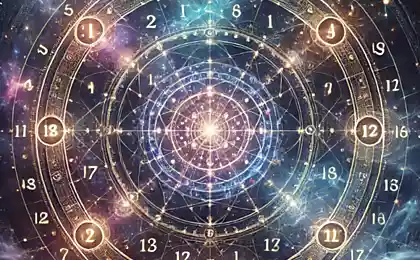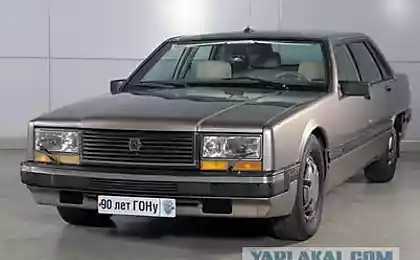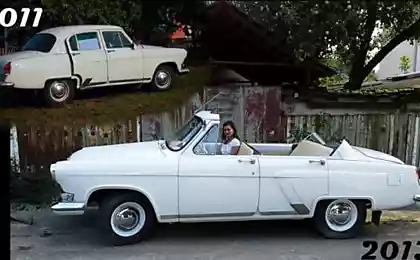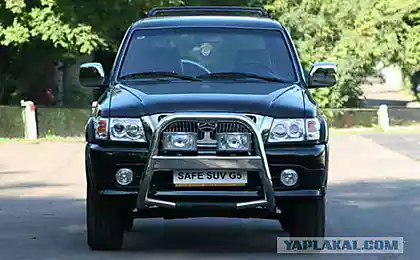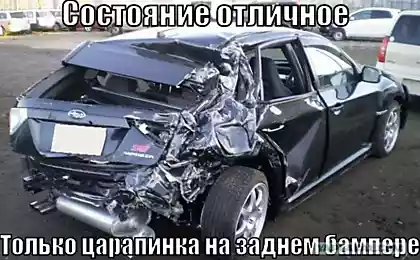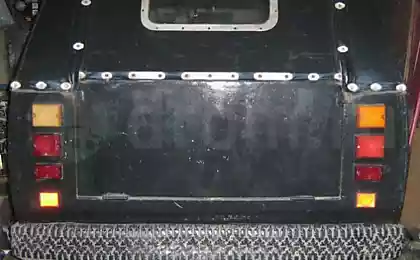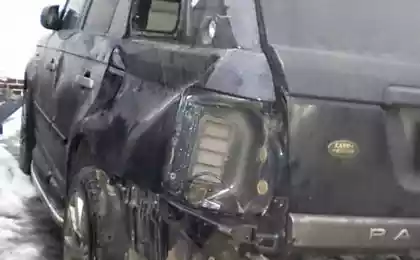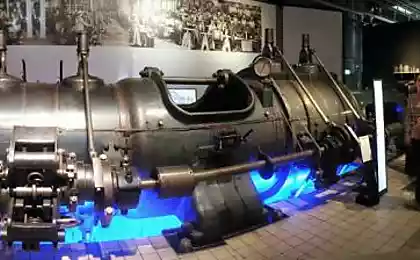3266
"Seven" - Machine amazing destiny
For many motorists Soviet VAZ-2107 car of the same sacred, both for Belarusians Volkswagen Passat B3. "Seven" - an amazing machine of fate appeared in 1982 as a Russian "Mercedes", in 2012, it has grown into one of the cheapest cars in the world.
About how I was for 30 years the most immutable car.
28 photos, text

02

In Soviet automobile plants have always been their own unique traditions. For example, AZLK "preached" the path of constant evolution, making cars one model, but were released in different years, could have a number of small, not always noticeable, but significant technical differences. In this new model units often "run-in" on the previous model. Therefore, for example, in the later "Moskvich-412" was a dashboard from 2140.
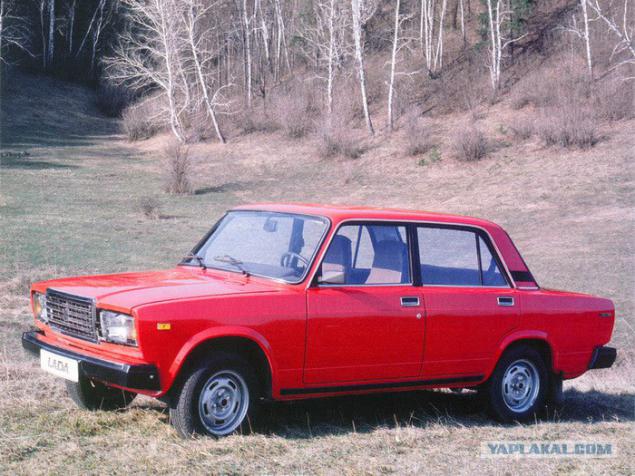
During the transition period, when production at the same time there were two models, often marketed as a new luxury version of the old and have increased the price. For example, the difference in the cost of the 408-th and 412-th model is 2000 rubles. The instructions to the "Lada" on the first page was written: "The design of vehicles is constantly being improved, so the individual components and units may differ slightly from those described in the manual." Despite this, "Lada" me weak. And there were two reasons.
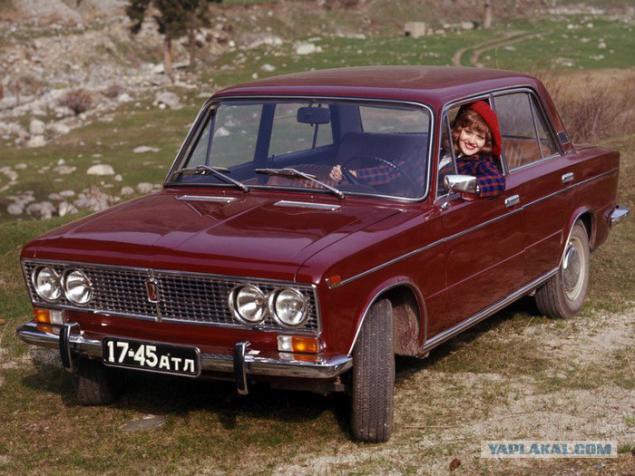
The first reason - the Italians gave the Soviets just three models: the "norm" (2101), "Suite" (2103) and "wagon" (2102). Although the independent model to call them, in truth, it is difficult - it was rather different configuration of one car.
The second reason - the WHA fast enough to form a clear plan of action, which meant the production of entirely new front-drive car, as soon as factory equipment fulfills the warranty period. However, there was one caveat - Fiat 124 was the 1967 models, VAZ-2101 became the conveyor only in 1970. But the world is not standing still, tightened rules on safety and environmental protection. To somehow keep export sales, it was necessary to upgrade the existing Fiat, leaving unchanged the floor, body shell and roof, not to change the still relatively new equipment.

Chief designer of the new "Lada" was George Mirzoyev, who undertook them, it can be said with the coming into office. The designer, who "painted" look of the updated "classics" was V.Stepanov, who worked under the direction of maestro vazovskogo M.Demidovtseva. To fulfill the safety standards vehicle lost vent front doors, bumpers received a tubular mount, radial tires, a door frame were provided for fastening protective timber. Motors received a 5-speed gearbox and a more "green" carburetor "Ozone", because of which the engine power is reduced from 77 to 72, 5 hp 2105/07 on the family have been "run-in" and some things that are reflected in the new "Samara". This halogen head lights, hydrocorrector headlights, the headlight, rear optics on printed circuit boards, single mounting unit relays and fuses tselnoformovannye interior parts, plastic bumpers and the timing belt.
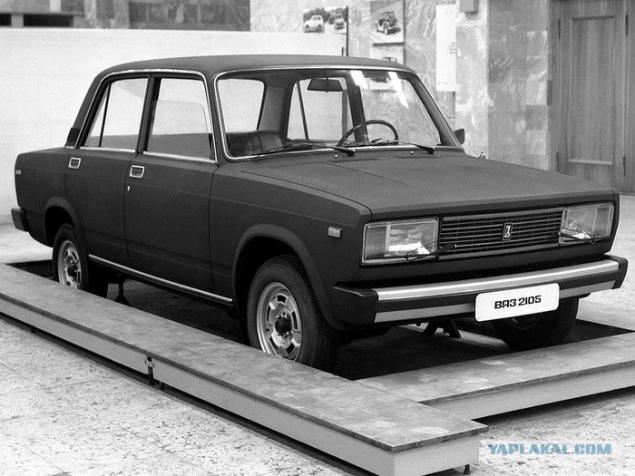
We must pay tribute to the designer Stepanov. He was to "draw" three cars at once - "norm", "universal" and "luxury", and draw so that cars can not be confused on the street. With the "luxury" troika Italian designers have been easier: its "luxury" emphasizes not only the belt molding and chetyrehfarnaya optics, but also more long wings, through which the machine was "shark" limber. Here are just a technology, it was not very comfortable - because of the wings and optics many details 2103/06 are not interchangeable with the items 2101.
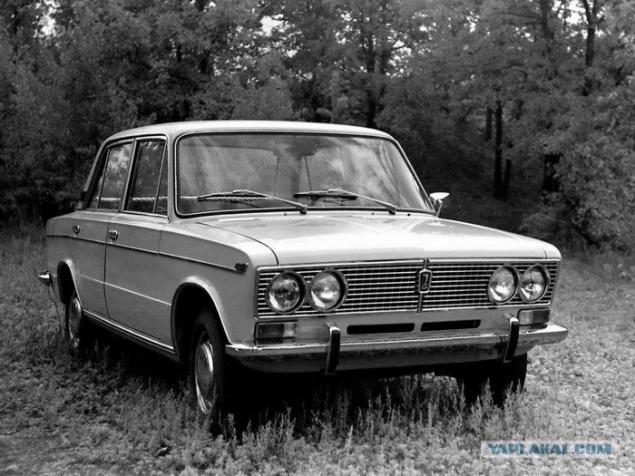
Stepanov was able to draw a VAZ-2107 so it was not like the 2105. In this case all parts were interchangeable. Happiness for technology!

Today it seems silly, but while AvtoVAZ promised party every year to produce one new car. The first family car 2105/07 went to trial in 1977. And in 1980, stood on the conveyor only model 2105, which was sold at the price of 8,000 rubles, and only in 1982, saw the light of the serial in 2107, which could be bought for 9,000 rubles. For comparison: the "luxury" brothers in 2103 and 2106 cost 7500 rubles and 8400, respectively. Two years to eliminate the difference allowed "childhood diseases" on the base model. They were associated with new rims, due to a defect which the first off the production line in 2105 with the familiar discs from 2103 and chrome "pies", and was also redesigned the front window, which reduced the weight of the door and remove unnecessary scratches.
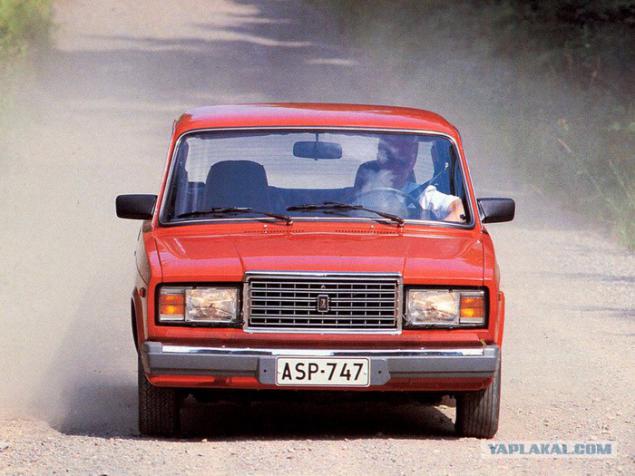
Initially, VAZ-2107 involves the following modifications:
- Model VAZ-2107 is equipped with engine VAZ-2103 volume 1450 cubic meters. cm and a capacity of 72, 5 hp RHD counterpart - the VAZ-21076;
- Model VAZ-21072 are equipped with engines of VAZ-2105 size 1300 cu. cm and a capacity of 63, 5 hp RHD counterpart - the VAZ-21077;
- Model VAZ-21074 are equipped with engines of VAZ-2106 volume 1570 cubic meters. cm and a capacity of 75, 5 hp RHD counterpart - the VAZ-21078.
Export cars traditionally have been called Lada instead cacophonous "Lada". In the UK and Canada in the name of the car was not an index. "Englishwomen" were called Lada Riva, «Canadians» - Lada Signet GL. At the same time, depending on market changes not only the name but also the "filling" of the car, for example, "charged" Lada Riva 1600SLX British passport was 9 seconds acceleration to 100 km / h. A Finnish «lighter» Konela Lada 2107 Turbo boasted 110 hp turbo engine and additional noise insulation. In both cases, the refinement of a car produced by AvtoVAZ dealers and had no relationship.
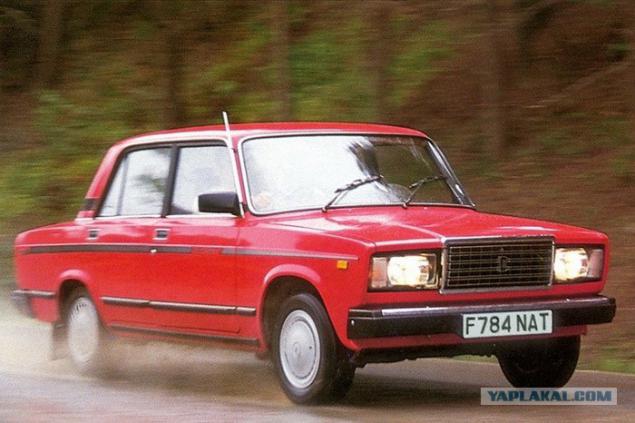
11

Another interesting point: the seat belts fitted to all cars, with some specimens were equipped with inertia seat belts seat belt alarm. However such advanced belts when buying a car is paid for separately. It is worth noting that for the VAZ-2107 was originally intended for more than 15 (!) Options to interior design. The most popular - black, very rare - light beige. However, all this variety was only available to Western buyers who ordered the car catalog "Autoexport." Soviet citizens were content to receive in turn.

At the design stage for the VAZ-2107 involves the use of a refrigerator, built-in rear armrest. Subsequently, from the fridge refused, but "rudimentny" contact to connect it came to mass production - it is in the floor under the feet of the right rear passenger. But the factory power windows, which sported an incredibly rare export "six", the Soviet 2107 and has not received because the factory did not bother with the development of the new ESP 5-roller drive circuit "long" front windows without panes.

As already mentioned, the VAZ-2107 was a "luxury" version of the model 2105. What distinguishes the model of "luxury" models of "normal"? Let's start with the external differences.

Primarily on the VAZ-2107 used plastic bumpers, which indeed happened detective story. The fact that the Soviet Union were able to make the best tanks, the most maneuverable aircraft, launch people into space on rockets and the very best to make huge chrome. But to make the most plastic part in the Union could not. By the way, that's why the GAZ-2410 with plastic grille appreciated stronger than with chrome. The bottom line is that the plastic bumper make the necessary strength in the USSR could not until 1990, therefore appealed to Yugoslavia, but there is no particular hurry. Had to order at the Turin firm "Gallino" not only mold, but they themselves bumpers. When I heard about the Italian competitors, Yugoslavs offered their bumpers suitable quality. This detective story is that according to official data in Turin was made 70 thousand bumpers. Imagine my surprise when I discovered the Italian bumpers on cars built for the domestic market at the end of November 1991!
Remarkably, but VAZ-2107, export to North America (called Lada Signet GL), equipped with bumpers 2105 Hydro, as they were better suited to the more stringent American safety requirements.

The second difference - mersedesovskaya grille. By default, Chrome, but there were cars and with a black plastic grille. By the way, that the original plastic grille is also available in Turin!

Connected with it is one story. The fact that the lattice caused complaint VAZ-2107 on increased fuel consumption, - wide "pig" and "hump" on the hood of the car's aerodynamics great spoil! Unfortunately, it turned out, when the VAZ-2107 are already being produced.

Last external difference from 2107 in 2105 - a rear light. It is worth noting that the usual format lanterns appeared in 2107 immediately. At the pre-drawing machines taillights was completely different, similar to that of the VAZ-2106, with a small section of the reversing lights, located in the center. Then came the more usual scheme, but in the middle of a lantern held a chrome strip. It is clearly visible in the picture, where the VAZ-2107 is the aerodynamic tests - those tests, which established the cause of the high fuel consumption. Soon chrome strip missing. To meet her, even on machines early years of release today a great success.

19

The most noticeable difference in the interior of VAZ-2107 is the dashboard. It is worth to mention the option of upgrading the 2103 offered by Porsche, which Volga car pretty tightly together. So, in this version of the series did not go, but some elements of the interior can be found on serial machines. VAZ-2105 was composed around the instrument panel control buttons, and in 2107 - the instrument panel with tachometer, located in the corners of the sensors and warning lights are arranged in one place.

Traditional "luxury" element of Soviet cars were "clock", in addition, the presence of the panel in 2107 was different installation locations for stereo radio, as well as a function of "summer blowout." At the time of the VAZ-2107 in the light it was quite a popular thing to be found, in particular, on the Mercedes: small air driven into the cabin air directly from the street, but due to the special design of the inlet air temperature was a couple of degrees lower than the overboard. Mersedesovsky final touch - steering characteristic shape.

"Luxury" model before 2105 emphasized and seat in the rear armrest was built in the style of 2106 and the front headrests and cast sported improved lateral support. By the way, it was the front seats have become one of the most popular complaints about the "seven", along with increased fuel consumption. The fact that the USSR machines though it was small, but trailering flourished. And when put on the conveyor VAZ-2101, with this fact considered - one of the upgrades were modified seat mountings, which allows to transform salon "penny" in a relatively flat makeshift "bed". Overnight same in 2107 has proved to be quite problematic.

Curious contrast to 2107 from 2105 - in the "luxury" model used by the door cards from 2106, while the 2105 model received a special card from tselnoformovannoy plastic. This is explained by the fact that the velor card from 2106 looked richer.
Here's a modest list of differences. Today, it seems ridiculous, but in the Soviet Union in 1982, VAZ-2107 is really seen as a completely new model, Russian "Mercedes", despite the fact that, in fact, is just the latest upgrade of the good old Fiat 124. It was expensive and coveted car which cost 9000 rubles. Expensive was only "Niva" (10,300 rubles) and "Volga" (11,200 rubles).
In 1984, the series went completely new VAZ-2108. Many solutions have been tested for this car to "fifth" of the family. But when the "eight" stood on the conveyor, it's time to share it with the "old man". What was the reason for the subsequent modernization of the "Lada", including the VAZ-2107.
Since 1986 VAZ-2107 began to install another starter, but the first really serious modernization befell him in 1988. The main difference - different layout of the dashboard.
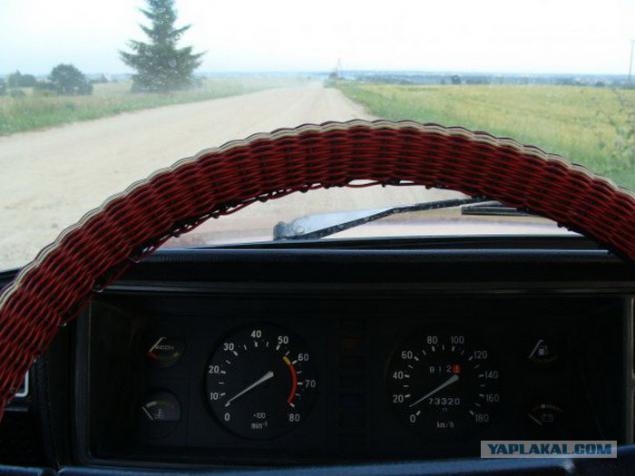
The first catches the eye is that on cars after 1988 in place of the oil pressure sensor were installed for the first time appeared on the same "Samara" flowmeter. In fact, the oil pressure sensor, and meter - is the most common gauge. Just since 1988, this became a manometer to measure the intake manifold vacuum. Also, change the font on the speedometer and tachometer was not just another picture "Redline", but a lot of the calibration marks. Also since 1988, began to install "vosmerochny" generator 55 A instead of the previous 45. But there was a negative change: since 1988 no longer place the sensors wear front brake pads (yes, until 1988. "Seven" sported this option!) .

Since that 1988 modification VAZ-21072 engine 2105 with the timing belt was supplanted old-chain motor 21011. This is due to the fact that the motor 2105 fulfilled his task, - with him VAZ mastered the production of belt motor, and when was arranged production Tractors "Samara", the need for a motor 2105 has disappeared. After all, it had to be made on one branch with chain motors, and it was technologically impractical.
With the development of some of the VAZ-2108 (mainly export) "Seven" were equipped with contactless ignition system, and carburetor "Solex" mechanically driven both cameras. Somewhere at the same time saw the light modification VAZ-2107-71 for the Chinese market. The peculiarity of this car - the engine VAZ-21033-10, which in 1450 the volume of a cube. gave 66 cm, 2 hp due to the fact that has been configured for gasoline A-76. Its main design feature of the pistons were VAZ-2108.
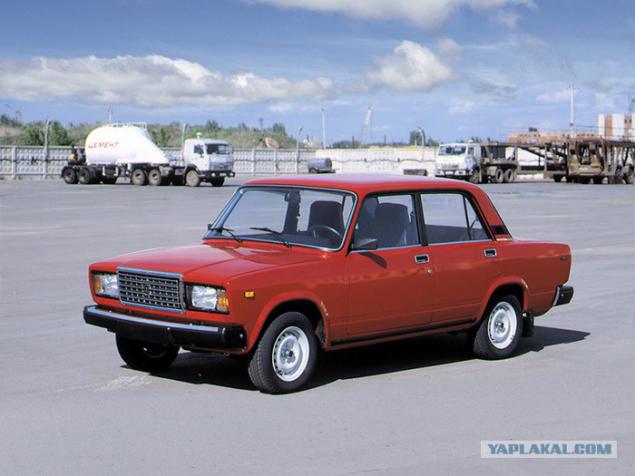
Next upgrade was truly global and occurred with VAZ-2107 in 1992. However, its cause was far from trivial. When in 1982 appeared VAZ-2107, it was a "luxury" car that was only one step below the "Volga", although cost is cheaper "Niva". If we arrange the cars by price for 1983, we can see the following picture:
- GAZ-24 "Volga" - 11.200 rubles;
- VAZ-2121 "Niva" - 10.300 rubles;
- VAZ-2107 "Lada" - 9000 rubles;
- VAZ-2106 "Lada" - 8400 rubles;
- AZLK-2140SL «Moskvich" - 8000 rubles;
- VAZ-2105 "Lada" - 8000 rubles;
- VAZ-2103 "Lada" - 7500 rubles;
- AZLK-2140 "Moskvich" - 7500 rubles;
- VAZ-2102 "Lada" - 7400 rubles;
- VAZ-21011 "Lada" - 6400 rubles;
- ZAZ-968M "Zaporozhets" - 5600 rubles.
With the advent of "eight" in 1984, "Seven" has not lost its "luxury", because it had 4 doors. Yes, and which was published "nine", the new hatchback, the Soviet people are treated with some prejudice - old sedan still remained the most "luxury". As of the 1991 "Seven" at a price equal to AZLK-2141 and cost 600 rubles more polutoralitrovye VAZ-21093. As of January 1, 1991, the USSR established the following car prices:
- GAZ-24-10 "Volga" - 16.200 rubles;
- VAZ-2107 "Lada" - 9700 rubles;
- AZLK-2141 "Moskvich" - 9600 rubles;
- VAZ-21093 "Lada Samara" - 9100 rubles;
- VAZ-2104 "Lada" - 9100 rubles;
- VAZ-2109 "Lada Samara" - 8900 rubles;
- VAZ-2121 "Field" - 9000 rubles;
- VAZ-2106 "Lada" - 9000 rubles;
- VAZ-2108 "Lada Sputnik" - 8300 rubles;
- VAZ-2105 "Lada" - 8300 rubles;
- Iz-21251 "combo" - 7800 rubles;
- Iz-412IE "Moskvich" - 7100 rubles;
- ZAZ-1102 "Tavria" - 5100 rubles;
- LuAZ-969M - 5100 rubles;
- ZAZ-968M - 3900 rubles;
- VAZ-1111 "Oka" - 3500 rubles.
And then in 1991 began an incredible race with prices and shortages, which all mix. However, VAZ was ready peredneprivodnyiy sedan 21099, which in the same 1991, stood on the conveyor. And dated 2107 has not had a chance "to keep the throne," the more so by the time motorists had rasprobovat "chisel" and realized that the front-wheel drive car in many ways better than the "classics". Therefore, in 1992, the once "luxury" sedan VAZ-2107 went through modernization, whose main aim was to reduce the cost of the car.

Externally, these machines can be distinguished by a rubberized drains (before they were chromed), and also on wheels, which were unified with VAZ-2106, but did not have the chrome nakladok- "pies". From the front doors missing light bulbs in the butt. Inside the changes more: leatherette door cards without pockets instead of velor, cheaper, but more durable new upholstery. Tselnoformovannye details interior design of the roof and rear struts were replaced with vinyl, similar VAZ-2106.
About how I was for 30 years the most immutable car.
28 photos, text

02

In Soviet automobile plants have always been their own unique traditions. For example, AZLK "preached" the path of constant evolution, making cars one model, but were released in different years, could have a number of small, not always noticeable, but significant technical differences. In this new model units often "run-in" on the previous model. Therefore, for example, in the later "Moskvich-412" was a dashboard from 2140.

During the transition period, when production at the same time there were two models, often marketed as a new luxury version of the old and have increased the price. For example, the difference in the cost of the 408-th and 412-th model is 2000 rubles. The instructions to the "Lada" on the first page was written: "The design of vehicles is constantly being improved, so the individual components and units may differ slightly from those described in the manual." Despite this, "Lada" me weak. And there were two reasons.

The first reason - the Italians gave the Soviets just three models: the "norm" (2101), "Suite" (2103) and "wagon" (2102). Although the independent model to call them, in truth, it is difficult - it was rather different configuration of one car.
The second reason - the WHA fast enough to form a clear plan of action, which meant the production of entirely new front-drive car, as soon as factory equipment fulfills the warranty period. However, there was one caveat - Fiat 124 was the 1967 models, VAZ-2101 became the conveyor only in 1970. But the world is not standing still, tightened rules on safety and environmental protection. To somehow keep export sales, it was necessary to upgrade the existing Fiat, leaving unchanged the floor, body shell and roof, not to change the still relatively new equipment.

Chief designer of the new "Lada" was George Mirzoyev, who undertook them, it can be said with the coming into office. The designer, who "painted" look of the updated "classics" was V.Stepanov, who worked under the direction of maestro vazovskogo M.Demidovtseva. To fulfill the safety standards vehicle lost vent front doors, bumpers received a tubular mount, radial tires, a door frame were provided for fastening protective timber. Motors received a 5-speed gearbox and a more "green" carburetor "Ozone", because of which the engine power is reduced from 77 to 72, 5 hp 2105/07 on the family have been "run-in" and some things that are reflected in the new "Samara". This halogen head lights, hydrocorrector headlights, the headlight, rear optics on printed circuit boards, single mounting unit relays and fuses tselnoformovannye interior parts, plastic bumpers and the timing belt.

We must pay tribute to the designer Stepanov. He was to "draw" three cars at once - "norm", "universal" and "luxury", and draw so that cars can not be confused on the street. With the "luxury" troika Italian designers have been easier: its "luxury" emphasizes not only the belt molding and chetyrehfarnaya optics, but also more long wings, through which the machine was "shark" limber. Here are just a technology, it was not very comfortable - because of the wings and optics many details 2103/06 are not interchangeable with the items 2101.

Stepanov was able to draw a VAZ-2107 so it was not like the 2105. In this case all parts were interchangeable. Happiness for technology!

Today it seems silly, but while AvtoVAZ promised party every year to produce one new car. The first family car 2105/07 went to trial in 1977. And in 1980, stood on the conveyor only model 2105, which was sold at the price of 8,000 rubles, and only in 1982, saw the light of the serial in 2107, which could be bought for 9,000 rubles. For comparison: the "luxury" brothers in 2103 and 2106 cost 7500 rubles and 8400, respectively. Two years to eliminate the difference allowed "childhood diseases" on the base model. They were associated with new rims, due to a defect which the first off the production line in 2105 with the familiar discs from 2103 and chrome "pies", and was also redesigned the front window, which reduced the weight of the door and remove unnecessary scratches.

Initially, VAZ-2107 involves the following modifications:
- Model VAZ-2107 is equipped with engine VAZ-2103 volume 1450 cubic meters. cm and a capacity of 72, 5 hp RHD counterpart - the VAZ-21076;
- Model VAZ-21072 are equipped with engines of VAZ-2105 size 1300 cu. cm and a capacity of 63, 5 hp RHD counterpart - the VAZ-21077;
- Model VAZ-21074 are equipped with engines of VAZ-2106 volume 1570 cubic meters. cm and a capacity of 75, 5 hp RHD counterpart - the VAZ-21078.
Export cars traditionally have been called Lada instead cacophonous "Lada". In the UK and Canada in the name of the car was not an index. "Englishwomen" were called Lada Riva, «Canadians» - Lada Signet GL. At the same time, depending on market changes not only the name but also the "filling" of the car, for example, "charged" Lada Riva 1600SLX British passport was 9 seconds acceleration to 100 km / h. A Finnish «lighter» Konela Lada 2107 Turbo boasted 110 hp turbo engine and additional noise insulation. In both cases, the refinement of a car produced by AvtoVAZ dealers and had no relationship.

11

Another interesting point: the seat belts fitted to all cars, with some specimens were equipped with inertia seat belts seat belt alarm. However such advanced belts when buying a car is paid for separately. It is worth noting that for the VAZ-2107 was originally intended for more than 15 (!) Options to interior design. The most popular - black, very rare - light beige. However, all this variety was only available to Western buyers who ordered the car catalog "Autoexport." Soviet citizens were content to receive in turn.

At the design stage for the VAZ-2107 involves the use of a refrigerator, built-in rear armrest. Subsequently, from the fridge refused, but "rudimentny" contact to connect it came to mass production - it is in the floor under the feet of the right rear passenger. But the factory power windows, which sported an incredibly rare export "six", the Soviet 2107 and has not received because the factory did not bother with the development of the new ESP 5-roller drive circuit "long" front windows without panes.

As already mentioned, the VAZ-2107 was a "luxury" version of the model 2105. What distinguishes the model of "luxury" models of "normal"? Let's start with the external differences.

Primarily on the VAZ-2107 used plastic bumpers, which indeed happened detective story. The fact that the Soviet Union were able to make the best tanks, the most maneuverable aircraft, launch people into space on rockets and the very best to make huge chrome. But to make the most plastic part in the Union could not. By the way, that's why the GAZ-2410 with plastic grille appreciated stronger than with chrome. The bottom line is that the plastic bumper make the necessary strength in the USSR could not until 1990, therefore appealed to Yugoslavia, but there is no particular hurry. Had to order at the Turin firm "Gallino" not only mold, but they themselves bumpers. When I heard about the Italian competitors, Yugoslavs offered their bumpers suitable quality. This detective story is that according to official data in Turin was made 70 thousand bumpers. Imagine my surprise when I discovered the Italian bumpers on cars built for the domestic market at the end of November 1991!
Remarkably, but VAZ-2107, export to North America (called Lada Signet GL), equipped with bumpers 2105 Hydro, as they were better suited to the more stringent American safety requirements.

The second difference - mersedesovskaya grille. By default, Chrome, but there were cars and with a black plastic grille. By the way, that the original plastic grille is also available in Turin!

Connected with it is one story. The fact that the lattice caused complaint VAZ-2107 on increased fuel consumption, - wide "pig" and "hump" on the hood of the car's aerodynamics great spoil! Unfortunately, it turned out, when the VAZ-2107 are already being produced.

Last external difference from 2107 in 2105 - a rear light. It is worth noting that the usual format lanterns appeared in 2107 immediately. At the pre-drawing machines taillights was completely different, similar to that of the VAZ-2106, with a small section of the reversing lights, located in the center. Then came the more usual scheme, but in the middle of a lantern held a chrome strip. It is clearly visible in the picture, where the VAZ-2107 is the aerodynamic tests - those tests, which established the cause of the high fuel consumption. Soon chrome strip missing. To meet her, even on machines early years of release today a great success.

19

The most noticeable difference in the interior of VAZ-2107 is the dashboard. It is worth to mention the option of upgrading the 2103 offered by Porsche, which Volga car pretty tightly together. So, in this version of the series did not go, but some elements of the interior can be found on serial machines. VAZ-2105 was composed around the instrument panel control buttons, and in 2107 - the instrument panel with tachometer, located in the corners of the sensors and warning lights are arranged in one place.

Traditional "luxury" element of Soviet cars were "clock", in addition, the presence of the panel in 2107 was different installation locations for stereo radio, as well as a function of "summer blowout." At the time of the VAZ-2107 in the light it was quite a popular thing to be found, in particular, on the Mercedes: small air driven into the cabin air directly from the street, but due to the special design of the inlet air temperature was a couple of degrees lower than the overboard. Mersedesovsky final touch - steering characteristic shape.

"Luxury" model before 2105 emphasized and seat in the rear armrest was built in the style of 2106 and the front headrests and cast sported improved lateral support. By the way, it was the front seats have become one of the most popular complaints about the "seven", along with increased fuel consumption. The fact that the USSR machines though it was small, but trailering flourished. And when put on the conveyor VAZ-2101, with this fact considered - one of the upgrades were modified seat mountings, which allows to transform salon "penny" in a relatively flat makeshift "bed". Overnight same in 2107 has proved to be quite problematic.

Curious contrast to 2107 from 2105 - in the "luxury" model used by the door cards from 2106, while the 2105 model received a special card from tselnoformovannoy plastic. This is explained by the fact that the velor card from 2106 looked richer.
Here's a modest list of differences. Today, it seems ridiculous, but in the Soviet Union in 1982, VAZ-2107 is really seen as a completely new model, Russian "Mercedes", despite the fact that, in fact, is just the latest upgrade of the good old Fiat 124. It was expensive and coveted car which cost 9000 rubles. Expensive was only "Niva" (10,300 rubles) and "Volga" (11,200 rubles).
In 1984, the series went completely new VAZ-2108. Many solutions have been tested for this car to "fifth" of the family. But when the "eight" stood on the conveyor, it's time to share it with the "old man". What was the reason for the subsequent modernization of the "Lada", including the VAZ-2107.
Since 1986 VAZ-2107 began to install another starter, but the first really serious modernization befell him in 1988. The main difference - different layout of the dashboard.

The first catches the eye is that on cars after 1988 in place of the oil pressure sensor were installed for the first time appeared on the same "Samara" flowmeter. In fact, the oil pressure sensor, and meter - is the most common gauge. Just since 1988, this became a manometer to measure the intake manifold vacuum. Also, change the font on the speedometer and tachometer was not just another picture "Redline", but a lot of the calibration marks. Also since 1988, began to install "vosmerochny" generator 55 A instead of the previous 45. But there was a negative change: since 1988 no longer place the sensors wear front brake pads (yes, until 1988. "Seven" sported this option!) .

Since that 1988 modification VAZ-21072 engine 2105 with the timing belt was supplanted old-chain motor 21011. This is due to the fact that the motor 2105 fulfilled his task, - with him VAZ mastered the production of belt motor, and when was arranged production Tractors "Samara", the need for a motor 2105 has disappeared. After all, it had to be made on one branch with chain motors, and it was technologically impractical.
With the development of some of the VAZ-2108 (mainly export) "Seven" were equipped with contactless ignition system, and carburetor "Solex" mechanically driven both cameras. Somewhere at the same time saw the light modification VAZ-2107-71 for the Chinese market. The peculiarity of this car - the engine VAZ-21033-10, which in 1450 the volume of a cube. gave 66 cm, 2 hp due to the fact that has been configured for gasoline A-76. Its main design feature of the pistons were VAZ-2108.

Next upgrade was truly global and occurred with VAZ-2107 in 1992. However, its cause was far from trivial. When in 1982 appeared VAZ-2107, it was a "luxury" car that was only one step below the "Volga", although cost is cheaper "Niva". If we arrange the cars by price for 1983, we can see the following picture:
- GAZ-24 "Volga" - 11.200 rubles;
- VAZ-2121 "Niva" - 10.300 rubles;
- VAZ-2107 "Lada" - 9000 rubles;
- VAZ-2106 "Lada" - 8400 rubles;
- AZLK-2140SL «Moskvich" - 8000 rubles;
- VAZ-2105 "Lada" - 8000 rubles;
- VAZ-2103 "Lada" - 7500 rubles;
- AZLK-2140 "Moskvich" - 7500 rubles;
- VAZ-2102 "Lada" - 7400 rubles;
- VAZ-21011 "Lada" - 6400 rubles;
- ZAZ-968M "Zaporozhets" - 5600 rubles.
With the advent of "eight" in 1984, "Seven" has not lost its "luxury", because it had 4 doors. Yes, and which was published "nine", the new hatchback, the Soviet people are treated with some prejudice - old sedan still remained the most "luxury". As of the 1991 "Seven" at a price equal to AZLK-2141 and cost 600 rubles more polutoralitrovye VAZ-21093. As of January 1, 1991, the USSR established the following car prices:
- GAZ-24-10 "Volga" - 16.200 rubles;
- VAZ-2107 "Lada" - 9700 rubles;
- AZLK-2141 "Moskvich" - 9600 rubles;
- VAZ-21093 "Lada Samara" - 9100 rubles;
- VAZ-2104 "Lada" - 9100 rubles;
- VAZ-2109 "Lada Samara" - 8900 rubles;
- VAZ-2121 "Field" - 9000 rubles;
- VAZ-2106 "Lada" - 9000 rubles;
- VAZ-2108 "Lada Sputnik" - 8300 rubles;
- VAZ-2105 "Lada" - 8300 rubles;
- Iz-21251 "combo" - 7800 rubles;
- Iz-412IE "Moskvich" - 7100 rubles;
- ZAZ-1102 "Tavria" - 5100 rubles;
- LuAZ-969M - 5100 rubles;
- ZAZ-968M - 3900 rubles;
- VAZ-1111 "Oka" - 3500 rubles.
And then in 1991 began an incredible race with prices and shortages, which all mix. However, VAZ was ready peredneprivodnyiy sedan 21099, which in the same 1991, stood on the conveyor. And dated 2107 has not had a chance "to keep the throne," the more so by the time motorists had rasprobovat "chisel" and realized that the front-wheel drive car in many ways better than the "classics". Therefore, in 1992, the once "luxury" sedan VAZ-2107 went through modernization, whose main aim was to reduce the cost of the car.

Externally, these machines can be distinguished by a rubberized drains (before they were chromed), and also on wheels, which were unified with VAZ-2106, but did not have the chrome nakladok- "pies". From the front doors missing light bulbs in the butt. Inside the changes more: leatherette door cards without pockets instead of velor, cheaper, but more durable new upholstery. Tselnoformovannye details interior design of the roof and rear struts were replaced with vinyl, similar VAZ-2106.
